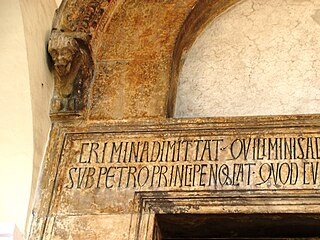
Guaimar IV was Prince of Salerno (1027–1052), Duke of Amalfi (1039–1052), Duke of Gaeta (1040–1041), and Prince of Capua (1038–1047) in Southern Italy over the period from 1027 to 1052. From 1041 to 1052 the Duke of Napoli was his vassal. He was an important figure in the final phase of Byzantine authority in the Mezzogiorno and the commencement of Norman power. He was, according to Amatus of Montecassino, "more courageous than his father, more generous and more courteous; indeed he possessed all the qualities a layman should have—except that he took an excessive delight in women."

Pandulf IV was the Prince of Capua on three separate occasions.
Richard Drengot was the count of Aversa (1049–1078), prince of Capua and duke of Gaeta (1064–1078).
Ranulf II was the count of Alife and Caiazzo, and duke of Apulia. He was a member of the Italo-Norman Drengot family which dominated the Principality of Capua for most of the century between 1050 and 1150. Ranulf's wife, Matilda, was the sister of King Roger II of Sicily.
William of Montreuil, was an Italo-Norman freebooter of the mid-eleventh century who was briefly Duke of Gaeta. He was described by Amatus of Monte Cassino as "an exceptional knight, small in stature, who was very robust, strong, valiant" and by Orderic Vitalis as 'the good Norman'.
Richard III, also known as Richard of Caleno, was the Norman count of Carinola and last quasi-independent Duke of Gaeta, ruling from 1121 to his death. From 1113, he was regent of Gaeta for his cousin or nephew, Duke Jonathan; in 1121 he succeeded him. As duke he was a nominal vassal of the Princes of Capua, to whom he was related.
The Drengots were a Norman family of mercenaries, one of the first to head to Southern Italy to fight in the service of the Lombards. They became the most prominent family after the Hautevilles.
Leo II was the Duke of Gaeta briefly in early 1042. He was the last duke of the native Docibilan family. His father was the magnificus Docibilis, a grandson of Duke Gregory. His brother, Hugh, was the count of Suio.
Atenulf I was the Lombard count of Aquino who rose to become Duke of Gaeta in Southern Italy during the chaotic middle of the eleventh century.
Landulf, either a Lombard count or a Docibilian senator, was the Duke and Consul of Gaeta from 1091 to 1103.
Geoffrey Ridel was the Duke of Gaeta as a vassal of the Prince of Capua from 1067 or 1068.

The Norman conquest of southern Italy lasted from 999 to 1194, involving many battles and independent conquerors.
Jonathan, a member of a cadet branch of the Drengot family, was the Duke of Gaeta from 1113 until his death. He is known from the Codex Caietanus to have been in the fourth year of his minority in 1116 and the seventh of his rule in 1119. There are three theories of his paternity. He may have been the son of Count Jonathan I of Carinola or his grandson by an unnamed son, or else the grandson of Count Bartholomew of Carinola. He was under the regency of his cousin or uncle, Count Richard of Carinola.
Raynald or Reginald Ridell was the Duke of Gaeta as a vassal of the Prince of Capua from 1086 until his death. He was both a son and a successor of Geoffrey Ridell.
Ridel is a surname. Notable people with the surname include:
Andrew was the Duke of Gaeta from 1111 until his death in 1113. He succeeded his father, Duke Richard II, upon the latter's death. He left no heir at his own death and his duchy escheated to Prince Robert I of Capua, his suzerain. His successor, Jonathan, was in power by May 1113.
Ranulf I was the count of Caiazzo in the Principality of Capua from about 1078. He also brought the formerly Lombard counties of Alife, Telese and Sant'Agata dei Goti and the castles of Airola and Tocco Caudio under his control, dominating the region between Capua and Benevento. He passed this territorial lordship on intact to his heirs, and it remained in their possession until the death of his grandson and namesake, Ranulf II, in 1139.

Richard was the Italo-Norman count of Rupecanina.

Robert was a south Italian nobleman who ruled the counties of Airola, Alife, Caiazzo, Sant'Agata and Telese from 1088 until his death. He was the regent of Capua in 1090–93, and was effectively independent of any lord after 1105. He was a major patron of churches and abbeys, and also commissioned several books.
Atenulf was the Abbot of Montecassino from 1011 until his death. He was a cousin of Prince Pandulf II of Capua, a younger son of Prince Pandulf III and brother of Prince Pandulf IV.